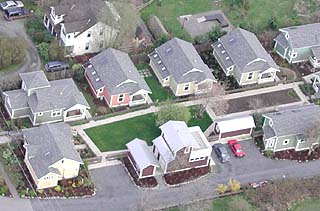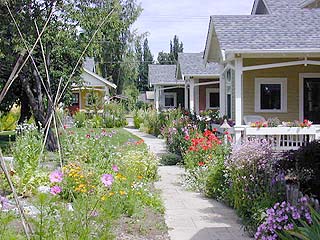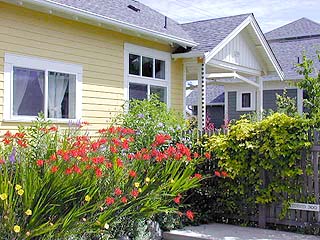
Surveys
DJC.COM
November 15, 2001
Small housing: A Northwest mini-trend
Special to the Journal

Photos courtesy of Ross Chapin Architect Third Street Cottages in Langley, on Whidbey Island, has captured national interest for its innovative style of developing small, friendly neighborhoods of smaller-than-conventional homes for those who don’t want subdivision mansions and huge lawns. |
If zoning changes are approved this month, Kaufman Crossing will rise on a 65-acre site occupied until 1996 by the old Croman Mill, a timber products plant. But it won’t look like a subdivision of tri-plex homes with three-car garages.
Pursuing a recent Northwest mini-trend toward smaller homes, closer neighbors and pedestrian living, Kaufman Crossing is being planned as a friendly community for young couples or retirees who want to enjoy more of an old fashioned neighborhood than modern developments offer.
“Super big houses don’t always fit an area’s demographics,” said Marcy McInelly, founder of Portland’s Urbsworks Inc., an architecture and urban design business. She’s leading the design team for the project, working with Galpin LLC, a group of Medford, Ore., developers.
“I think this represents a turning point for Ashland,” McInelly said. “The site is near a small lot, detached single-family (home) neighborhood with alleys, built during the railroad boom (between 1890 and 1920) to house ... railroad workers. Now it’s one of the most walkable ... desirable neighborhoods in Ashland.”
The rezoning request, which was expected to be put before city planning commission officials Nov. 13, would change the industrial tag on the property to allow residential developments with more housing density than normal — but smaller than normal.
Galpin’s proposed project would feature smaller homes of 1,000 square feet or less on 2,500-square-foot lots in a planned development that may even include rail transportation into the community, on the same tracks that once carried lumber out of the old timber mill.
|
Kaufman Crossing would offer a compatible mix of new housing, including single-story, one-bedroom homes with big windows, dormers to open up ceiling space and large porches.
Adjacent to the property is an existing commercial main-street-styled development with apartments above street-level businesses.
McInelly sees the need to provide housing for a neglected — but apparently growing — segment of society, those who don’t want mansions with huge lawns.
“I think (there are) people who want a smaller place to take care of, a smaller yard, room for a garden, close to neighbors and a detached house, not a row house. The whole key is that you spend less money on square footage and more money on detailing and exterior finishing,” she said.
The houses would sell for far less than Ashland’s present offerings of moderately-priced homes, in the $220,000 range, and while the square footage would also be less, she sees an increasing market for such housing.
Part of the project would provide space for a retirement community with independent and assisted-living services, perhaps even facilities for Alzheimer’s patients.
“People would be able to enjoy a comfortable, walkable, primarily residential neighborhood (some of the site may be developed for a school, a church and a tourist-oriented railroad museum) with a lot of room for gardening ... trees that make a canopy over the street ... and ‘skinny streets’ that promote pedestrian travel over motor vehicles,” she said.
Access to garages would be through alleys behind the homes and there would be community space for pocket parks, open areas, a village green and recreation pathways that connect with a regional biking trail.
To provide jobs in the area, the development may also include some manufacturing activities and other businesses, all of which would open up employment opportunities for residents of Kaufman Crossing.
If the project continues on schedule as expected, it could be under construction by next summer, with three to four years planned for full development, said Maurice Torano, a partner with the Galpin firm. The project would include roads as well as utilities, such as water, sewer and storm drain systems.

The small, old fashioned, colorful homes and yards in the Third Street Cottages neighborhood of Langley have an appeal to many people who are seeking smaller accommodations and a friendly people-oriented way to live. |

Hilltop House is typical of the eight small homes in the Third Street Cottages development that has become an award-winning example of the small-is-better trend in housing developments in the Pacific Northwest. |
“The existing Ashland neighborhood (around this site) is very homey and comfortable. We’re trying to bring some of those features into this new neighborhood. When the mill is gone we will have a large clear site to work with and we’re trying to adopt the very best of Ashland for this project,” she said.
While these types of small-is-better projects are still too few to be anything more than a footnote in the overall tabulation of housing developments in the Pacific Northwest, McInelly said there is definitely a growing trend and increasing interest.
She has already prepared similar design guidelines and development codes for NorthWest Crossing, a 500-acre “new urbanist” development in Bend, Ore.; Edwards Addition, an 85-acre site in Monmouth, Ore., and a new project for the city of Azusa, site of the last remaining undeveloped 500-acre parcel in Los Angeles County.
Also, in Washington state, new urbanist developments have been attracting attention since 1998 when Jim Soules of The Cottage Company LLC in Seattle and partner Ross Chapin of Ross Chapin Architects in Langley, on Whidbey Island, created a minimalist development in Langley dubbed The Third Street Cottages.
Chapin has already picked up two American Institute of Architects’ Western Home Awards, one for each of the two developments in Langley that have both sold out quickly.
“We started with this project (Third Street Cottages) with the idea of building cottage housing in a city. Instead of talking density, we were thinking intensity of living. Instead of four homes on 7,200-square-foot lots, we said let’s build eight 850-square-foot detached houses on smaller lots with front porches and quality rather than quantity of space,” said Soules, who terms his development “an alternative to conventional planning.”
The cluster of eight homes surrounding a common garden “is an exciting alternative for one and two-person households,” Chapin said. Others obviously agreed. Soules said he and Chapin were surprised at “the avalanche of inquiries from planning agencies, developers and architects from all over the country.”
Third Street Cottages garnered 10 pages in Sarah Susanka’s book “Creating the Not-So-Big House,” and the neighborhood project received the highest honor in the 1999-2000 AIA/Sunset Magazine Western Home Awards.
The October issue of Sunset is now featuring pictures of Soules and Chapin’s second small-home development in Langley, known as the Backyard Neighborhood project, which has just been chosen for another AIA/Sunset Western Home Award.
This latest project features somewhat larger homes but small cottages are still in the mix. Backyard Neighborhood consists of three adjacent 1,200-square-foot houses separated from 425-square-foot detached cottages at the back of the three lots by a shared alleyway.
The AIA jury called it “a flexible, high-density in-fill project that accommodates changing lifestyles” because the cottages can serve as home offices, separate family rooms, master bedrooms, starter homes for grown children, in-law quarters, guest cottages, studios or even long-term rentals.
“The larger houses combine kitchen, dining and living rooms in a single multifunctional space. Peaked ceilings, windows placed for maximum daylight and side-yard privacy, and light colors keep these great rooms open and bright,” the magazine article said. “The largest of the three, which is designed for wheelchair accessibility, also features an elevator and third-story view tower.”
Spurred by success, Soules and Chapin are finishing a new development near Shoreline Community College north of Seattle at Greenwood Avenue North and Northeast 160th Street, with eight cottages grouped around a landscaped courtyard, similar in character to the Third Street Cottages in Langley.
The development uses the common garden area to foster a cohesive community and provide a sense of place. Each cottage has a private yard, arranged around a commons with perennial flower borders, lawn and fruit trees. On the west side of the courtyard is a Commons Building with a multipurpose workshop for fixing bikes, planting seedlings or having a neighborhood party.
All of the cottages will have a large covered porch, flower boxes, gas fireplaces, wood floors, vaulted ceilings, great light and unique interior detailing. Each home has a single-car garage. The units — selling for around $269,900 — are sold as condominiums, with an association providing insurance, landscaping maintenance and cottage upkeep.
Soules is also involved in a joint venture with property owners on Bainbridge Island and local architect Charles Wenzlau, building 1,050-square-foot homes in a small development known as the Ericksen Cottages. The project was expected to break ground this month.
Always looking for new sites in the Puget Sound area, from two-thirds to two acres, for more small-home projects, Soules also wants to develop larger communities that would include shops, office, homes and cottages.
Further, in collaboration with Ross Chapin, Soules is offering cottage development consulting services to landowners, prospective residents, developers and city planning departments.
“I think it’s a significant trend,” Soules said. “Better rather than bigger, quality over quantity, it’s something people have been waiting for. It takes more work, details and supervision but — like the old pre-1940s craftsman homes with mantels and casings — they are homes that get a premium price.”
When people ask him what the cost per square foot is on his cottage projects, he said he knows they’re not “my kind of customer.”
“I like to ask them, ‘Do you buy a BMW by the pound?’ “ Soules said.
Terry Stephens is a freelance writer based in Arlington. He can be reached by e-mail at features@gte.net.
Other Stories:
- A peek into the architectural process
- Getting a project off the ground
- Head and shoulders above Sea-Tac
- High-rise homes with all the right stuff
- So you’re in it for the money
- What you need to know about your competitors
- Thea’s Landing: Downtown Tacoma’s new urban housing
- Rebirth of a Commencement Bay chateau
- New museum will have Tacomans glassy-eyed
- Beyond the urban core: Learning from the pioneers
- Achieving design certainty through collaboration
- Controlling stormwater the natural way
- Orchestrating Belltown’s rebirth
- Mechanical moxie: Innovations at the new Opera House
- Preserving a church gets personal
- Delivering the goods in a tight economy
- Don’t overlook moisture — the silent threat
- Designing a one-building ‘city’ on a Norwegian fjord
- The changing face of retail design
- Preserving affordable housing by design
- A cap over troubled waters
- Hospitality industry draws on refuge and prospect
Copyright ©2009 Seattle Daily Journal and DJC.COM.
Comments? Questions? Contact us.